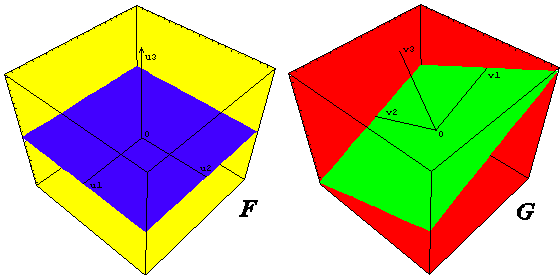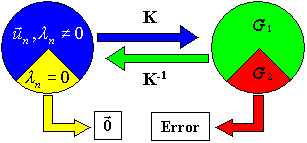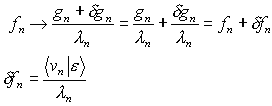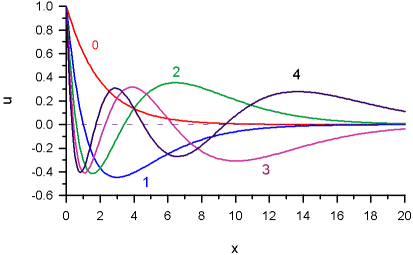Indirect and Remote measurements
Analysis of accuracy and resolution
Nikolai Shokhirev
- Singular Value Decomposition
- Analysis of accuracy and resolution
- Implementation
Introduction
This section is a continuation of the previous tutorial (see Singular Value Decomposition). Here we do not discuss any implementation issues (see Implementation).The basic equation is the integral equation of the first kind:
![]() (1)
(1)
The integral operator
![]() (2)
(2)
connects two in general different spaces: the space of reconstructing functions f(x) and the space of measuring functions g(x).
Definitions
Let us define:
- U is a set of all functions (vectors) { u n} (the complete basis set).
- U1 is a set of functions u n corresponding to non-zero

- U2 is the rest of basis functions u n
- V is the complete set of functions { vn }
- V1 = K U1 (is a set of functions vn
corresponding to non-zero
 )
) - V2 is the rest of basis functions vn
- F is the space spanned by the set of vectors U. In other
words, any vector f in U is a linear combination of all basis functions:
f = r1 u1 + r2 u2 + r3 u3 + . . . - The set of vectors U1 spans a subspace F1 of the space F
- The set U2 spans the subspace F2
- The basis set V forms the space of measuring functions G : f = s1 v1 + s2 v2 + s3 v3 + . .
- The subspace G1 is spanned by the set V1
- The subspace G2 is spanned by the set V2
3D-space Example
The three-dimensional space has only three basis vectors: U = {u1 , u2 , u3}. Let U1 = {u1 , u2} then u2 = { u3}. The space F is the whole 3D-space. The subspace F1 is the (u1 , u2)-plane (blue). The subspace F2 is the u3 -axis and not the rest of the space.
In this example the space G is also formed by the set of three basis vectors V = {v1 , v2 , v3}. The subspace G1 is the (v1 , v2)-plane (green). The subspace F2 consists of the u3 -axis.
 |
|
| F-space | G-space |
Mapping of Spaces
The operator (2) transforms the F-space in the following way

It maps the whole space F and the subspace F1 to G1. It maps the subspace F2 to 0.
Interpretation of Mapping
The last of the above equations means that the F2 components of a reconstructing function f do not produce the measuring signal in this experiment (instrument). This just reflects an incompleteness of this experiment. From the reconstruction viewpoint this is the source of instability of the inverse problem.
The F1 components produce a signal which is a function from the subspace G1. This signal can be used for reconstruction of the unknown function. It can be done by means of pseudo-inverse operator. Although it is not necessarily the best practical method of reconstruction.
There are no components in the F-space that produce a signal in the G2 subspace. If the right-hand side of the equation (1) contains components from the G2 subspace, then the equation does not have a solution.
The following picture summarize the interpretation

Use of singular functions
The singular functions (vectors) are natural bases for the integral operator (1) or for a given method of measurement.
- The basis set U1 is used for the construction of unknown function f. Only this part of the reconstructing function can be determined from the experiment. However, the U2 components can be used for additional shaping of the result, e.g. to make it smooth.
- The basis set V1 should be used for a natural filtering of measuring functions. All the V2 components of a signal must be filtered out before processing.
Experimental noise
In practice some random noise makes contribution to a signal:

It causes errors in the coefficients of reconstructed function:

The noise amplification factor can be defined as

Reconstruction criterion
Any f(x) that reproduces g(y) within an experimental errors is a solution of the equation (1).
Units of Information
The above criterion further restricts the set of functions within G1: only the components with the gn above the noise level should be taken into account. It also limits the set of functions un which can be used for reconstruction. The number of singular functions involved in reconstruction is the actual number of the units of information available for this instrument and noise level.
Accuracy and Resolution
The number of functions and their shape gives the answer for the following important questions
- What is the accuracy of reconstruction?
- What is the resolution?
- What is the region where the unknown function can be reliably reconstructed?
The accuracy is the largest amplitude of the rejected functions. The resolution is the shortest half-wavelength of the functions that can be used for reconstruction.
 |
|
Typical singular function behavior |
Reliable Reconstruction Region
Extremely useful characteristics which is usually ignored, is Reliable Reconstruction Region, RRR. It can be defined as a region where are situated the nodes (zeros) of the functions un used for reconstruction. In the above picture the RRR is approximately [0.5, 10].
Accuracy and Interval of Measurements
The accuracy of measurements and the interval of measurements affect the overall accuracy, resolution and Reliable Reconstruction Region. Analytical calculations and numerical experiments (see Implementation) show the following:
- The accuracy of measurements increases the number of singular function and primarily increases accuracy and resolution of reconstruction
- The extension of the interval of measurements modifies the integral operator (by increasing the interval [c,d], see Basics of Indirect Measurements) and increases the Reliable Reconstruction Region (e.g. the depth of detection, or interval of sizes).
References
- V.S.Bashurova, K.P.Koutsenogii, A.Yu.Pusep, N.V.Shokhirev. Determination of atmospheric aerosol size distribution functions from screen diffusion battery data: Mathematical aspects. J.Aerosol Sci., v.22, p.373-388, 1991.>
- A.Yu.Pusep, V.S.Bashurova, N.V.Shokhirev A.I.Burshtein. The development of the software for NMR-tomography of underground water. Tech. Report of the Institute of Chemical Kinetics and Combustion. Academy of Sciences of the USSR, Novosibirsk, 1991.
- N.V.Shokhirev, L.A.Rapatskii, A.M.Raitsimring. Electron-ion pair distribution function reconstructed from radiation-chemical and photochemical experiments. Chem.Phys., v.105, p.117-126, 1986.
- A.Yu.Pusep, N.V.Shokhirev. Determination of particle-size distribution functions in aerosols from measurements by diffusion batteries. Colloid J., v.48, p.108-113, 1986.
- N.V.Shokhirev, V.V.Konovalov, A.Yu.Pusep, and A.M.Raitsimring. Recovering the e-aq distribution in Photoemission. Theor.Exper.Chem., v.20, p.316-321, 1984.
- A.Yu.Pusep, N.V.Shokhirev. Application of a singular expansion for analyzing spectroscopic inverse problems. Opt.Spectrosc., v.57, p.482-486, 1984.